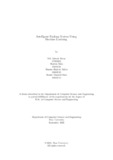| dc.contributor.advisor | Mostakim, Moin | |
| dc.contributor.advisor | Reza, Md Tanzim | |
| dc.contributor.author | Abrar, Md. Ishtiak | |
| dc.contributor.author | Saha, Shawon | |
| dc.contributor.author | Halim, Hamim Shabbir | |
| dc.contributor.author | Shafi, Shoaib Ahamed | |
| dc.date.accessioned | 2023-10-17T03:38:27Z | |
| dc.date.available | 2023-10-17T03:38:27Z | |
| dc.date.copyright | ©2022 | |
| dc.date.issued | 2022-09-28 | |
| dc.identifier.other | ID 17201155 | |
| dc.identifier.other | ID 18101531 | |
| dc.identifier.other | ID 18101542 | |
| dc.identifier.other | ID 18101544 | |
| dc.identifier.uri | http://hdl.handle.net/10361/21858 | |
| dc.description | This thesis is submitted in partial fulfillment of the requirements for the degree of Bachelor of Science in Computer Science and Engineering, 2022. | en_US |
| dc.description | Cataloged from PDF version of thesis. | |
| dc.description | Includes bibliographical references (pages 35-37). | |
| dc.description.abstract | In the last two decades, the quantity of automobiles has increased dramatically. As
a result, utilizing technology effectively to promote convenient parking at public and
private locations becomes critical. Conventional parking schemes make it difficult
for vehicles to discover available parking spaces. These methods overlook the fact
that vehicles are parked on roadways, poor time management during peak hours,
and incorrect vehicle parking in a parking space. Furthermore, typical methods in
a parking zone need greater human interaction. There is an urgent necessity to
create smart parking systems to address the aforementioned challenges. In order to
solve parking management in real time and uncertainty, the authors suggest a smart
parking system that makes use of IoT and machine learning techniques. The cloud,
cameras, and a cyber-physical system are all used in the suggested approach. The
creation of a graphical user experience for managers and end-users is a significant
task since it necessitates assuring the parking system’s smooth monitoring, management, and security. Furthermore, it must build seamless coordination with a user.
The proposed system is effective at wisely dealing with challenges. For instance, it
denotes the condition of a parking space to the end-user well beforehand; use of limited and unreserved parking places; incorrect parking; unpermitted parking; proper
data analysis of unrestricted and occupied spaces; identifying numerous items in a
parking space; fault identification in one or more subsystems; and peak-hour traffic
management. The approach saves a lot of time, money, and energy by reducing the
need for human involvement. | en_US |
| dc.description.statementofresponsibility | Md. Ishtiak Abrar | |
| dc.description.statementofresponsibility | Shawon Saha | |
| dc.description.statementofresponsibility | Hamim Shabbir Halim | |
| dc.description.statementofresponsibility | Shoaib Ahamed Shafi | |
| dc.format.extent | 48 pages | |
| dc.language.iso | en | en_US |
| dc.publisher | Brac University | en_US |
| dc.rights | Brac University theses are protected by copyright. They may be viewed from this source for any purpose, but reproduction or distribution in any format is prohibited without written permission. | |
| dc.subject | Vehicle parking system | en_US |
| dc.subject | R-CNN | en_US |
| dc.subject | YOLOv5 | en_US |
| dc.subject | Machine learning | en_US |
| dc.subject | Comparative analysis | en_US |
| dc.subject.lcsh | Computational intelligence | |
| dc.subject.lcsh | Intelligent transportation systems | |
| dc.title | Intelligent parking system using machine learning | en_US |
| dc.type | Thesis | en_US |
| dc.contributor.department | Department of Computer Science and Engineering, Brac University | |
| dc.description.degree | B.Sc. in Computer Science and Engineering | |

